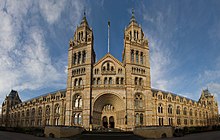Edward J. Miers
Edward John Miers
Biography

Miers was born in
Miers was appointed curator of the crustacean collections at the Natural History Museum in April or May 1872, taking over from Arthur Gardiner Butler who had been curator of insects, crustaceans, myriapods and arachnids. Miers was charged solely with the Crustacea and "to act as amanuensis to Dr. Gray" (John Edward Gray).[1]

In the 1880s, the Natural History Museum was in the process of moving its collections from the main
Miers was still working on material from the Alert expedition, when six boxes containing the
Miers tendered his resignation on 30 October 1885. The curation of the crustacean collection was handed to Jeffrey Bell, but Bell only published one paper on crustaceans, and the task of curation was soon shared with Reginald Innes Pocock. Miers lived to the age of 79, and died on 15 October 1930 at Burchetts Green, near Maidenhead, Berkshire.[1]
Taxa

A number of taxa are named in Miers' honour:[4]
- Miersia Kingsley, 1880 – Caridea: Oplophoridae (name suppressed in favour of Acanthephyra [5])
- Anchistus miersi (De Man, 1888) – Caridea: Palaemonidae
- Metapenaeopsis miersi Holthuis, 1952 – Dendrobranchiata: Penaeidae
- Amphipoda: Maeridae
- Parthenope miersi (A. Milne-Edwards & Bouvier, 1898) – Brachyura: Parthenopidae
- Clorida miersi Manning 1968 – Stomatopoda: Squillidae
- Pseudidotheidae
Taxa named by Miers include:
- Alpheus novaezealandiae – a species of shrimp
- Hexapodidae – a family of crabs
- Hippolyte bifidirostris – a species of shrimp
- Justitia mauritiana – a species of spiny lobster
- amphipod
- Parathranites – a genus of crabs
- Paratya – a genus of shrimp
- Porcellionides – a genus of woodlouse
- Portunus trituberculatus – gazami crab
- Potamonautes johnstoni – a species of terrestrial crab
- Trapeziidae – a family of crabs
- Upogebia danai – a species of mud lobster
References
- ^ ISBN 0-565-09016-X.
- ^ "Edward J. Miers (1851–1930)". Natural History Museum. Archived from the original on 21 June 2015. Retrieved 17 January 2010.
- ^ a b Isabella Gordon (1971). "Biographical note on Edward John Miers, F.Z.S., F.L.S. (1851–1930)". Koukakurui No Kenkyuu (Crustacean Research). 4/5: 123–132.
- ^ Hans H. Hansson. "Biographical Etymology of Marine Organism Names". Göteborgs Universitet. Archived from the original on 5 February 2012. Retrieved 16 January 2010.
- ^ "Genus Acanthephyra A. Milne Edwards, 1881". Australian Faunal Directory. Department of the Environment, Water, Heritage and the Arts. 9 October 2008. Retrieved 17 January 2010.
External links
- Works by or about Edward J. Miers at Internet Archive
- Edward J. Miers (1876). Catalogue of the stalk- and sessile-eyed crustacea of New Zealand. London: E. W. Janson. Available through Internet Archive
- "Portrait: Edward J. Miers (1851–1930)". Natural History Museum.
